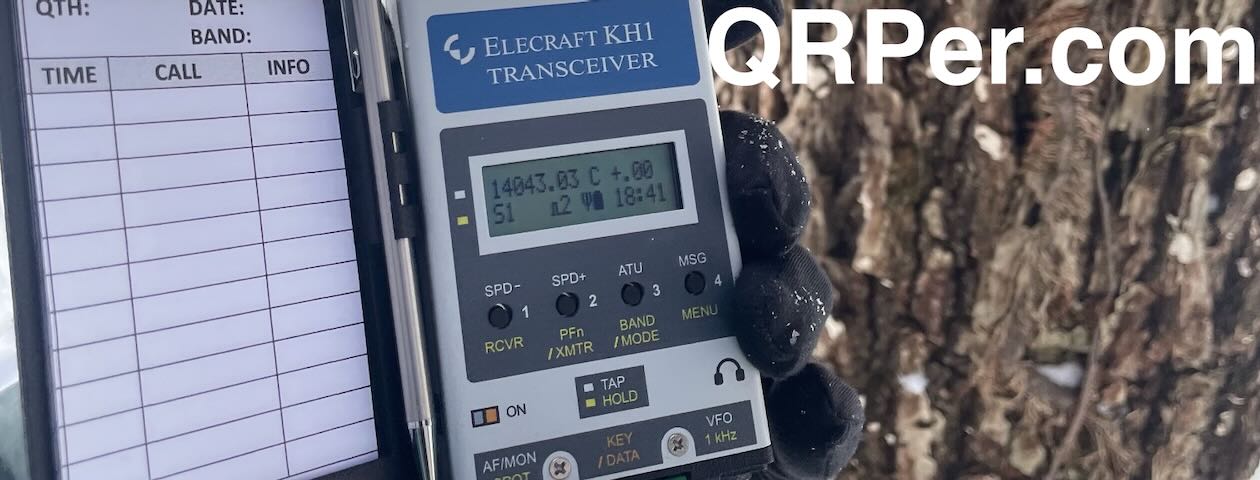Many thanks to Evan (K2EJT) who shares the following article about his portable field radio kit which will be featured on our Field Kit Gallery page. If you would like to share your field kit with the QRPer community, read this post. Check out Evan’s field kit:
FX-4CR Field Activation Kit
by Evan (K2EJT)
I have a lot of QRP field radios (more than I need and then some). Some of them are one trick ponies, and some of them can do several things very well. One radio, however, does everything well, and ticks every box for me. It’s tiny, well built, runs all modes very well, has 20w output, a color waterfall, and doesn’t break the bank.
That radio is the FX-4CR from BG2FX. Now, before I sing the praises of this little radio, I need you to know that it wasn’t always great. In fact, when I first got it it was pretty painful to use. I’m primarily a CW operator, so if a radio is lousy for CW, it doesn’t get used.
This radio was pretty atrocious on CW when I first got it. Keying was strange. It would miss dits and dahs. It had all sorts of popping and artifacts when you sent. It was fine on receive……but sending was pretty much unusable. I got it, used it for one activation in May, and then put it away in my gear closet, disgusted at how bad it was for CW.
Fast forward to the August 2023 firmware update, and Yu fixed all of the weird CW bugs, and now I can wholeheartedly sing the praises of this radio.
This kit lives in a Pelican case I’ve had forever. I forget which model it is (it’s so old the label fell off years ago), but it fits the kit nicely.
Inside the case you’ll find everything you need for a field activation. Notice I didn’t say a CW activation……ANY activation.
CW? Absolutely. In fact, with the latest firmware this radio is an absolute pleasure to send on.
SSB? Heck yeah. The audio from this radio is very good. The external hand mic is tiny but well built, and the radio even has an internal mic which is quite good as well.
Digital? Ah….digital. Now THAT’S what sets this radio apart from pretty much any other QRP field radio out there aside from the IC705. This thing has a built in sound card, so digital is a breeze. Wait….you forgot your USB cable you say? Not a problem, because this thing has Bluetooth digital as well, and it works flawlessly. You’ll notice a cell phone in the pictures. I run FT8 on that via Bluetooth using an Android application called FT8CN. All you need is the rig and your phone, and you’re in business.
Aside from the rig itself and the Pelican case, this kit contains the following:
- Bioenno 3ah battery
- The hand mic
- Power cable
- cwmorse.us key
- Retractable 3.5mm cable
- Rite in the Rain notepad for logging
- Pentel mechanical pencil
- Weaver 8oz throw weight and 65’ of hi viz reflective cordage
- 15’ of RG316 coax
- Spark Plug Antennas EFHW and a homebrew wire for the antenna
- The user manual
- My phone for FT8
(Gear links below)
There are also a set of flip down laptop legs on the radio from Amazon to get the viewing angle correct.
Now, this radio isn’t perfect (no radio is). There are a few things to keep in mind.
First, it’s small, but it’s heavy (530g or almost 19oz). Second, because it’s a 20w radio and it’s as small as it is, it can get hot…..very hot if you’re running digital.
Third, the firmware update process is a little nerve wracking. Aside from that, it’s a pretty sweet little radio for $550. It would be nice if it had an internal battery and a tuner, but I can live without those considering how much functionality is packed into this little rig.
 Out of every field radio I own (and as I said, I own a ton), this one is probably the most capable. It’s amazing for CW (finally), SSB, and digital. It’s tiny. It’s 20w. It isn’t crazy expensive. If I’m doing anything other than just CW in the field, this is one of the radios I grab most often. Is it the best radio I own? No. Is it awesome for what it is? Absolutely!
Out of every field radio I own (and as I said, I own a ton), this one is probably the most capable. It’s amazing for CW (finally), SSB, and digital. It’s tiny. It’s 20w. It isn’t crazy expensive. If I’m doing anything other than just CW in the field, this is one of the radios I grab most often. Is it the best radio I own? No. Is it awesome for what it is? Absolutely!
Evan
K2EJT
Gear Links:
- Radio (FX-4CR)
- Bioenno Battery
- CW Morse key
- 3.5mm cable
- Rite in the Rain pad
- Mechanical Pencil
- Throw weight
- Throw Line
- Coax (RG-316 Cable Assembly)
- Antenna
- Pelican Case
- Laptop legs
Readers: Check out Evan’s YouTube channel for more field radio goodness.


























































